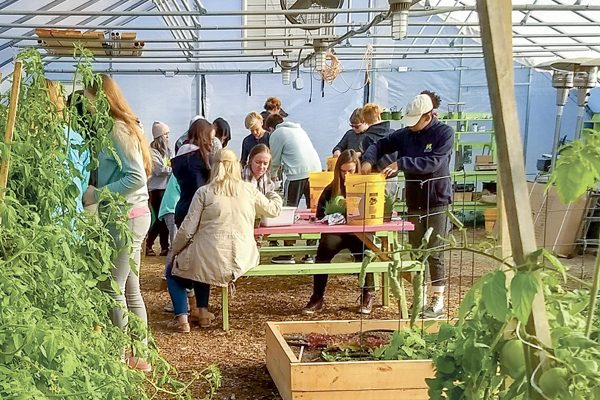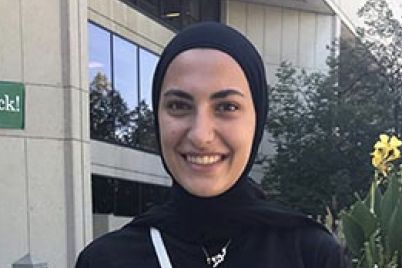
The hoop house grows chamomile, basil, lavender, dahlias, sunflowers, asparagus and more. Rachel Duckett | Contributor
Rachel Duckett
Contributor
Ryegrass, lavender, and chamomile eagerly poke their heads through the soil, as the rich smell of earth fills the warm air of the white, cloth enclosure.
If you asked the average Washtenaw Community College student what resides behind the Entrepreneurship Center, very few, if any, would be able to tell you about the hoop house, a half cylindrical structure made of piping and cloth, trapping heat to allow plants to flourish, even in the peak of a Michigan winter.
Former home to the CORE (Campus Orchard Rejuvenating Energy) garden, the hoop house was the brainchild of WCC counselor, Kim Groce, former director of CORE. CORE, funded by the college, was designed to educate culinary students on the importance of farm-to-table cooking, and grew fresh produce to give away to students in need.
A year ago, in 2017, CORE’s funding was discontinued, and Washtenaw Technical Middle College (WTMC) assumed the operations of the hoop house in Spring of 2018.
“I don’t know why the college was no longer able to fund the CORE Farm, but I am happy that WTMC was able to step in and take it over for their students,” said Groce, “I love the work that they have done out there. I plan to volunteer there this spring and help out in any way that I can.”
According to Dr. Covert, Dean of WTMC, the hoop house is fully funded by WTMC, and is being integrated into their science curriculum, with hopes of building an outdoor classroom next year.
“We are in the midst of crafting new science and critical-thinking curricula that will use the hoop house as an outdoor lab,” said Eli Zemper, Director of the garden and member of WCC’s Sustainability Council, “we are interested in continuing to think about sustainability, the major focus of our freshman program, and systems thinking.”
In the past year, WTMC students have built 12 new garden beds, and mulched and weeded the garden as part of their physical education course.
In addition to strawberries, spinach, oregano, mint, thyme and sage planted by Groce, WTMC added chamomile, basil, lavender, dahlias, sunflowers, asparagus, lettuce, kale, radishes, six kinds of tomatoes, carrots, beets, rutabagas, peas, beans, pumpkins, four kinds of potatoes, watermelon and cucumbers. Produce was picked twice a week by students and staff at WTMC.
Outside the hoop house, there are more garden beds, two bio-digesters belonging to the college, and a worm bin, filled with compost, including coffee grounds from The Spot. A plot of land is delegated for 60 apple trees to be donated to WCC, which was built on land that used to be an apple orchard, by Tim Strickler, Zemper’s stepfather.
“The vision for the hoop house is to function as an outdoor learning lab for students who attend WTMC, but also to service diverse stakeholders within the community,” said Zemper.
With the assistance of another WTMC science teacher, and two Environmental Studies interns, Zemper fosters multiple partnerships throughout the community, including the Young Adult Education program, who uses the space for job training, and on-campus robotics teams working on STEM projects.
Moving forward this spring, Zemper plans to create an aquaponics system using a 300 gallon fish tank.
“When the aquaponics system is up and running, we will have an opportunity to examine a circular system that uses the waste production of fish as the input for growing leafy greens,” she said.
Students will learn about food shortage and observe and compare soil and water growing methods in order to propose which method is most effective for our climate.
“We envision the hoop house as a place to explore how food is grown as well as the political and social issues surrounding the access to fresh, affordable, healthy foods for all,” said Zemper.
Next fall, WTMC hopes to build an outdoor classroom, as well as introduce a class designed to just be in the hoop house.
Although the hoop house is only available to WTMC students, according to Zemper, the doors remain unlocked, allowing students from the college to take a break from their busy school days to visit the garden.
“It’s good for your mental health,” said Zemper, who said she hopes that students continue to respect the garden, so the doors can stay open.
Unlike CORE, WCC students do not receive food grown by WTMC. However, the college’s Student Resource Center does have an Emergency Food Pantry that provides two bags of food or hygiene products to enrolled students facing food poverty. While the Emergency Food Pantry only provides dry goods, they do offer fresh market days a couple of times a year.
Students and locals will have the chance to enjoy the garden this February 16th, when the hoop house will host the Local Food Summit.



One Reply to “Growth in the hoop house”
Comments are closed.